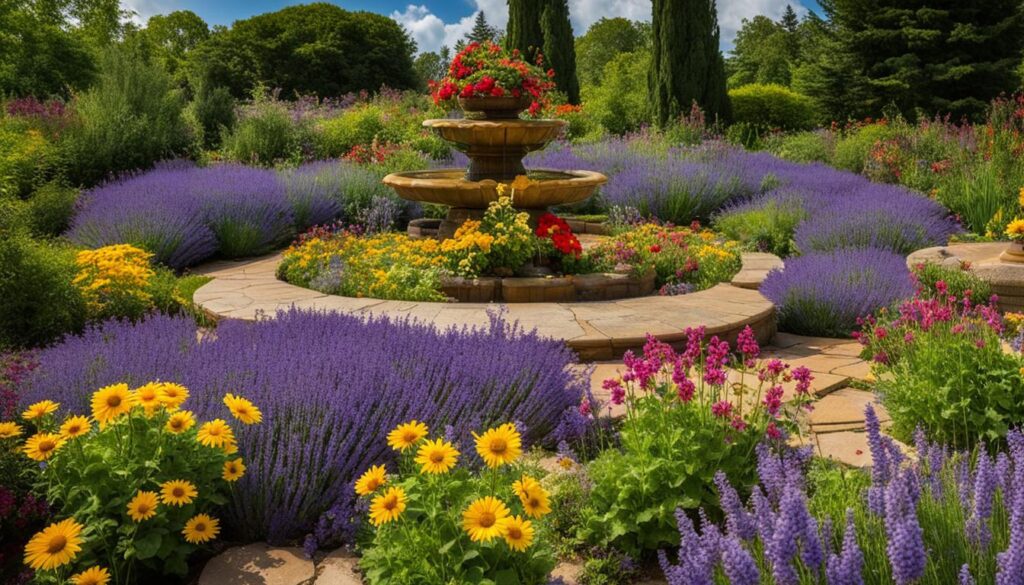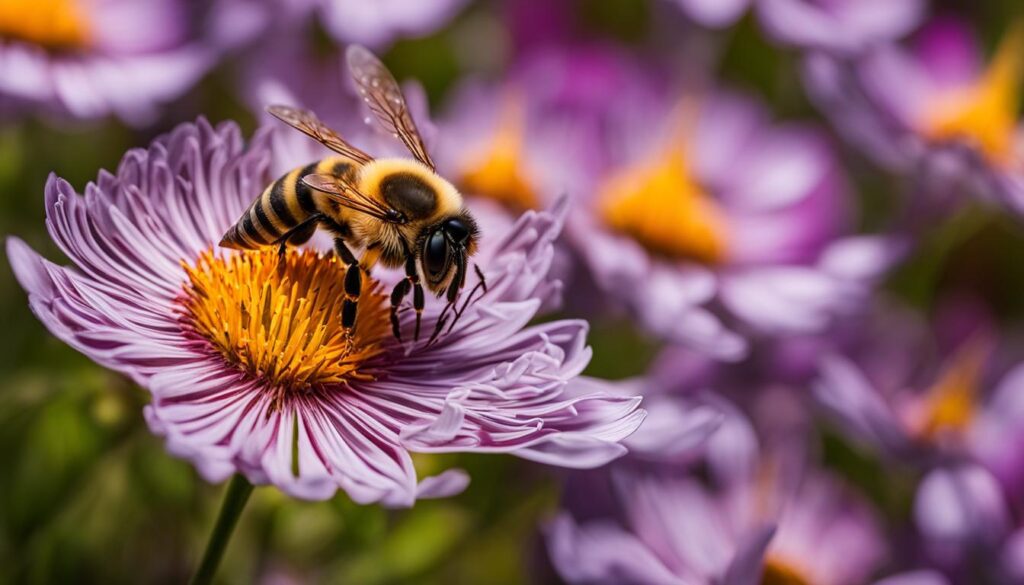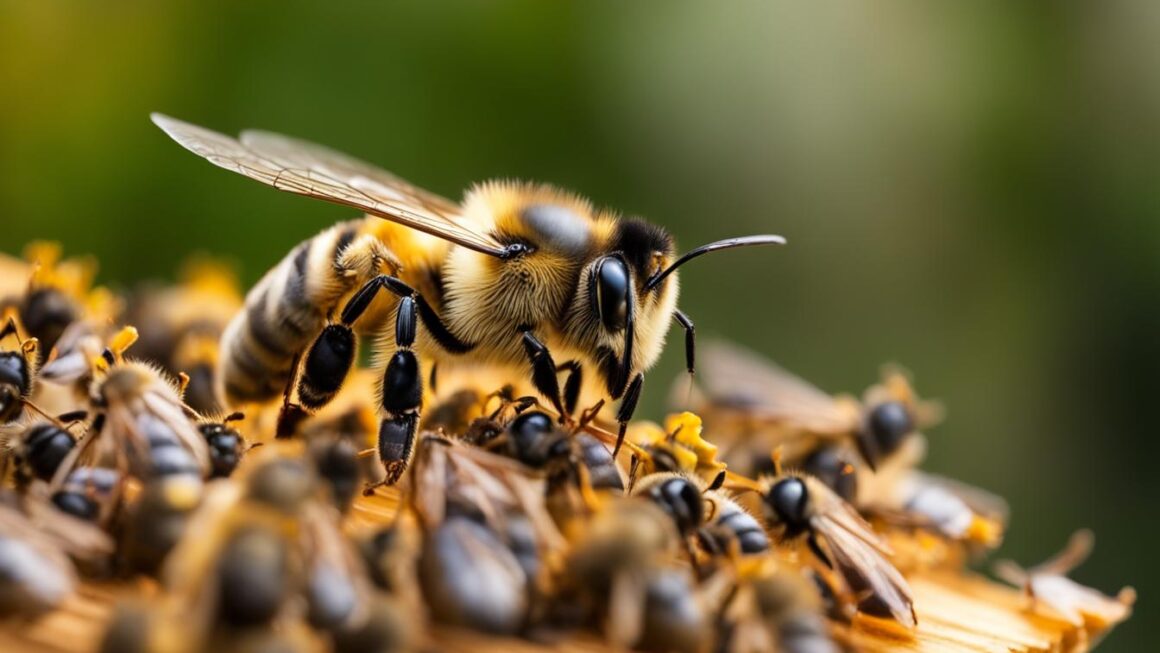Spring is the perfect time to capture the beauty of bees through photography. In this section, we will explore advanced techniques that will help you capture stunning images of bees in their natural habitat. From capturing the hive to understanding beekeeping techniques and honey production methods, we’ll cover all the essentials to elevate your bee photography skills.
Key Takeaways:
- Capturing bees in photography requires skill and technique.
- Using an interchangeable lens camera with a macro lens provides the best results.
- Set your camera to a fast shutter speed and wide aperture to freeze bee movement.
- Consider composition, background, and capturing the bee’s angle for well-composed shots.
- Diffused light works best for macro photography.
Recommended Gear for Bee Photography
When it comes to capturing stunning photographs of bees, having the right gear is essential. Here are some recommended beekeeping equipment and supplies to enhance your bee photography:
1. Interchangeable Lens Camera:
An interchangeable lens camera, such as a mirrorless or DSLR camera, provides versatility and control over settings. These types of cameras allow you to attach different lenses, including a macro lens for close-up shots of bees. With the ability to adjust settings like shutter speed and aperture, you can freeze the bee’s movement and blur the background, resulting in captivating images.
2. Macro Lens:
A macro lens is a must-have for bee photography. It enables you to focus on the intricate details of bees, capturing their delicate features and vibrant colors. Macro lenses have a close focusing distance, allowing you to get up close and personal with your subjects. Look for a lens with a focal length between 90mm and 105mm for optimal results.
3. Lighting Equipment:
Controlling lighting conditions is crucial for bee photography. Natural diffused light works best for capturing the fine details of bees without harsh shadows. However, if the lighting conditions are not ideal, additional lighting equipment such as diffusers can be used to soften and distribute the light evenly. This ensures that your photographs showcase the bees in their best light.
| Recommended Gear for Bee Photography |
|---|
| Interchangeable Lens Camera |
| Macro Lens |
| Lighting Equipment |
By investing in the right gear, you can take your bee photography to the next level. Remember to experiment with different settings and techniques to find your unique style and capture the beauty of these incredible creatures.
Tips for Creating a Bee-Friendly Garden
Creating a bee-friendly garden is a wonderful way to support bee health management and hive management practices. By providing a welcoming environment for bees, you can help these important pollinators thrive. Here are some tips to create a garden that will attract bees and contribute to their well-being:
- Choose Native Plants: Native plants are a great food source for bees as they provide pollen and nectar. Select a variety of native plants that bloom at different times throughout the year to ensure a continuous food supply for bees.
- Create a Diverse Habitat: Incorporate features like bee hotels and leave some areas of your garden overgrown. These habitats provide nesting opportunities for bees and contribute to their overall health and survival.
- Avoid Pesticides: Minimize or eliminate the use of pesticides in your garden as they can be harmful to bees and other beneficial insects. Instead, opt for organic pest control methods or natural alternatives.
- Provide a Water Source: Bees need access to water, so consider adding a shallow bird bath or a small water feature to your garden. Place some pebbles or floating plants in the water to provide a landing spot for bees.
- Plant for All Seasons: Choose a variety of plants that bloom in different seasons. This ensures a consistent food source for bees throughout the year, supporting their health and longevity.
By following these tips, you can create a bee-friendly garden that not only attracts bees for photography but also promotes their well-being. Remember, bees play a vital role in pollination and contribute to the health of our environment, so it’s important to support their populations by providing a suitable habitat.

Quote:
“A bee-friendly garden is not only beautiful but also contributes to bee health management and hive management practices. By providing a diverse range of native plants, habitats, and avoiding pesticides, we can create a haven for these essential pollinators.” – Beekeeping expert
Creating a bee-friendly garden is an enjoyable and rewarding endeavor. Not only will you have the opportunity to capture stunning photographs of bees, but you will also be making a positive impact on their well-being. So grab your camera and get ready to witness the beauty of bees in your own backyard!
Timing and Lighting for Bee Photography
Capturing stunning images of bees requires careful consideration of timing and lighting. Understanding when bees are most active and how to manipulate lighting conditions can greatly enhance your photography. In this section, we will explore the best time to photograph bees and various lighting techniques to create captivating images.
Best Time for Bee Photography
Early morning is ideal for bee photography as bees are typically slower and calmer during this time. The golden hour, which occurs just after sunrise and before sunset, offers soft and warm lighting that adds a beautiful glow to your images. During these times, the angle and quality of light create a magical atmosphere, enhancing the details of the bees and their surroundings.
Lighting Techniques
When it comes to lighting, diffused natural light is often the preferred option for bee photography. Diffusers can be used to soften the harshness of direct sunlight and create a more even and flattering lighting situation. Alternatively, using a flash with a diffuser can provide controlled lighting and freeze the bee’s motion, resulting in sharp and detailed images. It’s important to be mindful of the distance and angle of the flash to avoid causing stress or harm to the bees.
Considerations for Bee Behavior and Nutrition
Timing and lighting can also be influenced by bee behavior and nutrition. For example, knowing the peak times for queen bee rearing can allow you to capture unique moments of interaction between the queen and worker bees. Additionally, considering the nutritional aspect of flowers can attract more bees to your photography location, increasing the chances of capturing vibrant and active subjects.
By understanding the best times to photograph bees and utilizing appropriate lighting techniques, you can elevate your bee photography to new heights. The interplay between timing, lighting, and bee behavior creates opportunities for capturing mesmerizing and awe-inspiring images.
Composition and Background Considerations
When capturing bee photography, composition and background play a crucial role in creating visually striking shots. By paying attention to these elements, you can enhance the overall aesthetic appeal of your images.
One important consideration is the rule of thirds. This compositional guideline suggests dividing your frame into nine equal parts using two horizontal and two vertical lines. The intersecting points of these lines are known as “power points,” and they can help you place your main subject, such as a bee, in a visually pleasing way.
In addition to the rule of thirds, it’s important to consider the bee’s surroundings and incorporate elements of its environment into your composition. This could include flowers, plants, or other natural elements that provide context and add interest to your photos.
Background and Lighting
When composing your shots, it’s crucial to pay attention to the background. A clean and uncluttered background helps to highlight the bee as the main subject and prevents any distractions that could take away from the overall impact of the image. Look for backgrounds that provide contrast and make the bee stand out.
Lighting is another essential aspect of composition. Consider the angle and direction of light to create interesting shadows and highlights. Diffused natural light works best for macro photography, as it provides a soft and flattering illumination that enhances the details of the bee.
Enhancing Composition with Bee-Friendly Plants
When selecting plants for your bee-friendly garden, it’s not only important to choose varieties that provide pollen and nectar but also consider the nutritional aspect. Bees are attracted to flowers with high nutritional value, as they play a crucial role in their overall health and well-being. Incorporating a diverse range of plants with different nutritional profiles can help attract a variety of bee species and contribute to the overall composition of your images.
| Flower Type | Nutritional Value |
|---|---|
| Sunflowers | High |
| Lavender | Moderate |
| Salvia | High |
| Wildflowers | Varies |
By combining thoughtful composition, a clean background, and selecting bee-friendly plants with high nutritional value, you can create visually stunning images that not only showcase the beauty of bees but also raise awareness about the importance of honeybee nutrition in their overall well-being.

Table: Recommended Techniques for Capturing Bees in Flight
| Technique | Description |
|---|---|
| Use a telephoto lens with a long focal length | Avoid getting too close to the bees while still capturing detailed shots of them in flight |
| Set a fast shutter speed | Freeze the fast movement of bees and avoid motion blur in your photographs |
| Pre-focus on an area | Increase your chances of capturing sharply focused images by anticipating where the bees are likely to fly |
| Use continuous shooting mode | Capture multiple shots in rapid succession to increase the likelihood of getting the perfect shot |
Manual Focus and Using a Tripod
In bee photography, manual focus can be a valuable technique to ensure that the bee’s eyes are sharp and in focus. By adjusting the focus distance and pre-focusing on a specific area, you can increase the chances of capturing detailed and well-focused images of bees. Manual focus gives you more control over the focus point, allowing you to highlight specific features and create stunning close-up shots.
Using a tripod can also greatly benefit your bee photography. It provides stability, allowing you to maintain a steady position while waiting for the perfect shot. A tripod helps reduce camera shake, resulting in sharper images, especially when photographing bees that are resting on flowers. It also allows you to experiment with different angles and compositions without the risk of blurring your photos.
A tripod paired with manual focus allows you to have precise control over your images, ensuring that every detail of the bee and its surroundings is captured with clarity. Whether you’re capturing a bee in flight or a stationary bee on a flower, manual focus and a tripod can significantly enhance the quality of your bee photography.
Benefits of Manual Focus and Using a Tripod:
- Increased control over the focus point, ensuring sharp and detailed images
- Stability and reduced camera shake, resulting in sharper photos
- Opportunity to experiment with different angles and compositions
- Precise control over capturing every detail of the bee and its surroundings
Table: Recommended Tripods for Bee Photography
| Tripod Model | Max Height | Min Height | Weight |
|---|---|---|---|
| Manfrotto MT055XPRO3 | 178 cm | 9 cm | 2.5 kg |
| Gitzo GT1545T | 154 cm | 22 cm | 1.42 kg |
| Vanguard Alta Pro 263AB | 173 cm | 15 cm | 2.38 kg |
“Using manual focus and a tripod has been a game-changer for my bee photography. It allows me to capture incredible details and create stunning compositions. The tripod ensures stability, while manual focus enables me to control the exact point of focus. These techniques have elevated the quality of my images and brought a new level of precision to my craft.” – Professional Bee Photographer
Using Flash for Bee Photography
When it comes to bee photography, using flash can be a helpful technique to enhance your images. By providing additional light, flash can help freeze the bee’s motion and balance the exposure, resulting in sharper and more vibrant photographs. However, it’s essential to use flash in a way that ensures the bee’s well-being and minimizes any potential harm or stress.
One important consideration when using flash is to diffuse the light. This can be achieved by attaching a diffuser or softbox to your flash unit. Diffusing the light helps create a softer and more natural-looking illumination, avoiding harsh shadows and reducing the risk of overwhelming the bee. It’s crucial to avoid direct and intense flash, as this can startle the bee or cause unnecessary stress.
Additionally, it’s recommended to position the flash at an angle that minimizes the chance of direct light hitting the bee’s eyes. Bees are sensitive to light, and direct flash can potentially harm their vision. By angling the flash slightly away from the bee or bouncing it off a nearby surface, you can create a more indirect and diffused light source, resulting in a gentle and flattering illumination.
Ultimately, using flash in bee photography requires thoughtful consideration and an understanding of the bee’s behavior and health. By employing diffused light, being mindful of the flash’s position and intensity, and respecting the well-being of the bee, you can effectively incorporate flash to capture stunning images while ensuring the welfare of these incredible creatures.
Table: Pros and Cons of Using Flash in Bee Photography
| Pros | Cons |
|---|---|
|
|
Conclusion
In conclusion, bee photography offers a unique opportunity to capture the beauty and importance of these incredible creatures. By employing advanced techniques, utilizing the recommended gear, and creating a bee-friendly garden, you can master the art of capturing breathtaking images of bees.
It is crucial to remember the role of bees in honey production and apiary management. These industrious insects play a vital role in pollination, contributing to the production of honey. Through your bee photography, you can raise awareness about the significance of bees and their impact on our ecosystem.
As you embark on your bee photography journey, always approach these fascinating creatures with respect and caution. Understanding their behavior and creating a safe and welcoming environment in your garden will ensure the well-being of bees and the success of your photography endeavors.
Embrace the Buzzing Beauty
Capturing the hive through bee photography requires both patience and technique. By applying the knowledge gained from this article, you can embark on a rewarding photographic journey that showcases the unique beauty and importance of bees in honey production and apiary management.
FAQ
What gear do I need for bee photography?
It is recommended to use an interchangeable lens camera, such as a mirrorless or DSLR, with a macro lens for close-up shots.
How do I create a bee-friendly garden?
Choose native plants with pollen and nectar to provide a food source for bees. Incorporate features like bee hotels and leave overgrown areas for bee habitats.
When is the best time for bee photography?
Early morning and the golden hour, just after sunrise and before sunset, offer the best lighting conditions for capturing bees.
How can I capture bees in flight?
Use a telephoto lens with a long focal length, set a fast shutter speed, and pre-focus on an area. Continuous shooting mode can also increase your chances of getting the perfect shot.
Should I use manual focus or autofocus for bee photography?
Manual focus gives you more control over the focus point, but autofocus can also be used. Pre-focusing and adjusting the focus distance can help ensure the bee’s eyes are in focus.
Do I need to use a flash for bee photography?
Using a flash with a diffuser can provide optimal lighting conditions, freeze the bee’s motion, and balance exposure. However, it’s important to consider the bee’s behavior and health when using flash.
How can I capture well-composed bee photos?
Consider composition, background, and capturing the bee’s angle. Use the rule of thirds, keep the background uncluttered, and pay attention to colors and textures.




